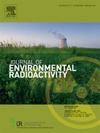Toward a modification of the soil compartment of the CSA N288.1 environmental transfer model for permafrost conditions
IF 2.1
3区 环境科学与生态学
Q3 ENVIRONMENTAL SCIENCES
引用次数: 0
Abstract
The Canadian road map for Small Modular Reactors (SMRs) details that possible uses for SMRs includes providing electricity to remote communities. Many of the communities in the Canadian Arctic use diesel fuel generators to provide electricity. SMRs provide a possible future alternative to the combustion of fossil fuels in these communities. This has been done before by the United States Army Nuclear Power Program (ANPP) and Russia currently uses two SMRs to supply electricity in the Arctic. For power reactors in Canada, Derived Release Limits must be calculated using the N288.1 environmental compartment model. There is a compartment for soil in the N288.1 model that includes a few different soil types. However, the compartment is not suitable for soils that are underlain by permafrost (cryosols). In this paper we describe how the N288.1 soil compartment could be modified for permafrost conditions, and specifically those representative of the continuous permafrost zone, where 90–100 % of the ground underlying the surface is perennially frozen. We provide example calculations using the modified version of the N288.1 soil compartment representative of conditions around Inuvik, a site in continuous permafrost. In general the specific calculations of the modified N288.1 standard tend to decrease the value of the P13 (air to soil) transfer factor.
冻土条件下CSA N288.1环境转移模型土壤分室的修正
加拿大小型模块化反应堆(smr)路线图详细说明了smr的可能用途,包括为偏远社区提供电力。加拿大北极地区的许多社区使用柴油发电机供电。小型反应堆为这些社区提供了一种可能的替代化石燃料燃烧的未来选择。美国陆军核电计划(ANPP)之前已经这样做过,俄罗斯目前使用两个smr在北极供电。对于加拿大的动力反应堆,衍生释放限值必须使用N288.1环境隔室模型计算。在N288.1模型中有一个土壤隔间,其中包括几种不同的土壤类型。然而,该隔室不适用于冻土(冻土层)下的土壤。在本文中,我们描述了如何修改N288.1土壤隔室以适应永久冻土条件,特别是那些代表连续永久冻土带的土壤隔室,在这些永久冻土带中,地表下90 - 100%的地面常年冻结。我们提供了使用改良版的N288.1土壤隔间的例子计算,代表了Inuvik附近的条件,一个连续的永久冻土层。总的来说,修改后的N288.1标准的具体计算有降低P13(空气到土壤)传递系数值的趋势。
本文章由计算机程序翻译,如有差异,请以英文原文为准。
求助全文
约1分钟内获得全文
求助全文
来源期刊

Journal of environmental radioactivity
环境科学-环境科学
CiteScore
4.70
自引率
13.00%
发文量
209
审稿时长
73 days
期刊介绍:
The Journal of Environmental Radioactivity provides a coherent international forum for publication of original research or review papers on any aspect of the occurrence of radioactivity in natural systems.
Relevant subject areas range from applications of environmental radionuclides as mechanistic or timescale tracers of natural processes to assessments of the radioecological or radiological effects of ambient radioactivity. Papers deal with naturally occurring nuclides or with those created and released by man through nuclear weapons manufacture and testing, energy production, fuel-cycle technology, etc. Reports on radioactivity in the oceans, sediments, rivers, lakes, groundwaters, soils, atmosphere and all divisions of the biosphere are welcomed, but these should not simply be of a monitoring nature unless the data are particularly innovative.
 求助内容:
求助内容: 应助结果提醒方式:
应助结果提醒方式:


